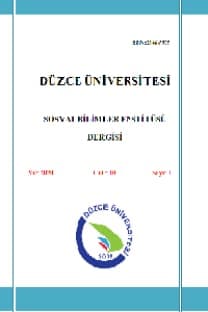THE ROLE OF EMOTIONAL SATISFACTION IN GIFT GIVING BEHAVIOR: A QUALITATIVE RESEARCH
Gift Giving, Emotion, Emotional Satisfaction
___
Referans 1 -Bagozzi, R. P., Gopinath, M., & Nyer, P. U. (1999). The Role of Emotions in Marketing. Academy of Marketing Science, 184-206.Referans2- Banks , S. K. (1979). Gift Giving: A Review and an Interactive Paradigm. Advances in Consumer Research, 6, 319-324.
Referans3-Beatty, S. E., Kahle, L. R. & Homer, P. (1991). Personal Values and Gift-Giving Behaviours: A Study Across Cultures. Journal of Business Research, 22(March), 149-157.
Referans4-Belk, R. W. & Coon, G. S. (1993). Gift-Giving as Agapic Love: An Alternative to the Exchange Paradigm Based on Dating Experiences. Journal of Consumer Research, 20(December), 393-417.
Referans5-Belshaw, C. S. (1965). Traditional Exchange in Modern Markets, Englewood Cliffs, NJ: Prentice-Hall.
Referans6-Caplow, T. (1982). Christmas Gifts and Kin Networks. American Sociological Review, 47, 383-392.
Referans7-Cronin, J. J., Brady, M. K., & Hult, T. (2000). Assessing the Effects of Quality, Value and Customer Satisfaciton on Consumer Behavioral Intentions in Service Environments. Journal of Retailing 76(2), 193-218.
Referans8-Ekman, P. (1994). “All Emotions Are Basic”. In (Eds.) Ekman P. Davidson, J. R. The Nature of Emotion: Fundamental Questions. New York: Oxford University Press, 15-20.
Referans9-Garner, T. I. & Wagner, J. (1991). Economic Dimansions of Household Gift-Giving. Journal of Consumer Research, 33(2), 283-290.
Referans10-Gouldner, A. (1960). The Norm of Reciprocity: A Preliminary Statement. American Sociological Review, 25, 176-177.
Referans11-Güler, A., Halıcıoğlu, M. B., & Taşgın, S. (2013). Sosyal Bilimlerde Nitel Araştırma: Teorik Çerçeve Pratik Öneriler, Altı Farklı Nitel Araştırma Yaklaşımı, Kalite ve Etik Hususlar. Ankara: Seçkin.
Referans12-Mauss, M. (1950). The Gift Forms and Functions of Exchange in Archaic Societies (I. Cunnison, Trans.). London: CohenveWest Ltd.
Referans13-Roest, H. C. & Pieters, R. (1997). The Nomological Net of Perceived Service Quality. International Journal of Service Industry Management 8(4), 336-351.
Referans14-Ruth, J. A., Otnes, C. C., & Brunel, F. F. (1999). Gift Receipt and The Reformulation of Interpersonal Relationships. Journal of Consumer Research, 25(March), 385-402.
Referans15-Schwartz, B. (1967). The Social Psychology of The Gift. The American Journal of Sociology, 73(1), 1-11.
Referans16-Sherry, J. J. (1983). Gift-Giving in Anthropological Perspective. Journal of Consumer Research, 10(September), 157-168.
Referans17-TDK (2020). Türk Dil Kurumu Sözlüğü. https://www.tdk.gov.tr/, (Date of Access: 26.08.2020).
- ISSN: 2146-5975
- Yayın Aralığı: Yılda 2 Sayı
- Yayıncı: Düzce Üniversitesi
KİŞİLİK ÖZELLİKLERİNİN SÜPERMARKETLERDEKİ PLANSIZ ALIŞVERİŞ DAVRANIŞLARINA ETKİSİ: BOLU ÖRNEĞİ
ÖRGÜTSEL GÜVEN İLE SANAL KAYTARMA ARASINDAKİ İLİŞKİDE YÖNETSEL DESTEK ALGISININ DÜZENLEYİCİ ETKİSİ
Gülşah GENÇER ÇELİK, Erkan TAŞKIRAN, Gizem TAŞKIN
SİBER SALDIRILARA KARŞI KOBİLERİN FARKINDALIK DÜZEYLERİNİN İNCELENMESİ: ANKARA İLİ ÖRNEĞİ
1890-1899 YILLARI ARASINDA EDİRNE VİLAYETİNDE SIĞIR VEBASI: VEBÂ-YI BAKARÎ
RUANDALI ÖĞRENCİLERİN YAZILI ANLATIMLARININ YANLIŞ ÇÖZÜMLEMESİ YÖNTEMİNE GÖRE İNCELENMESİ
THE ROLE OF EMOTIONAL SATISFACTION IN GIFT GIVING BEHAVIOR: A QUALITATIVE RESEARCH
Nilgün SARIKAYA, Nilgün KÖKSALAN
HAREZMŞAHLARI YIKIMA GÖTÜREN OLAY: OTRAR FACİASI (1218)
ÜNİVERSİTE KONUMLANDIRMASINDA FARKLILAŞMA BOYUTU: FIRAT ÜNİVERSİTESİ ÖRNEĞİ
